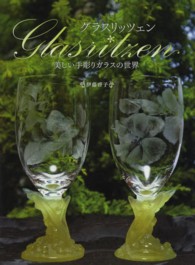- ホーム
- > 洋書
- > ドイツ書
- > Humanities, Arts & Music
- > History
- > 20th century (1914-1955/49)
Description
(Text)
Perhaps the most enduring image of the China Trade is the clipper ship carrying tea from China. In 1869 the clippers were finally overshadowed by the introduction of steam vessels which could make passage through the Suez Canal, significantly shortening the length of the voyage. Letters, journals and order books have survived which tell us about the traders, their private trading activities, motivation, tastes and private lives. This book examines the role played by the port of Liverpool in this time of great change. The book examines Liverpool's early participation in the China Trade following the cessation of the British East India Company's monopoly of the trade in 1834 and maps the changes in artistic tastes that the commencement of free trade gave rise to. These new tastes represented a true fusion of European and Chinese cultural influences and replaced the pastiche of 'The Orient' that chinoiserie represented during the period of the monopoly.
(Table of content)
Contents: Liverpool merchants' role in the cessation of the east India Company monopoly - Changes in trading practise - Sail to steam - Letters and journals left by the traders revealing aspects of private trade - Changes in taste, patronage and privately traded art commodities.
(Review)
"...a fascinating and well researched book." (A. W. Purdue, Northern History)
(Author portrait)
The Author: Christina Baird wrote a doctoral dissertation at the School of Oriental and African Studies, University of London on which this book is based. She then worked as Curator of Oriental Collections at the National Museums and Galleries on Merseyside before pursuing her post-doctoral studies preparing this publication with the Paul Mellon Centre for Studies in British Art, London. She has also worked as a professional lecturer on many aspects of art history and has published widely on the subject.






